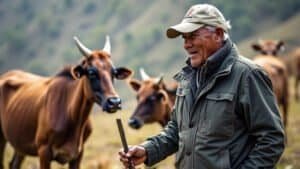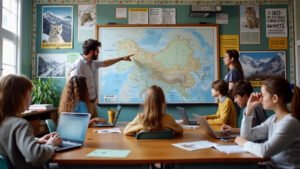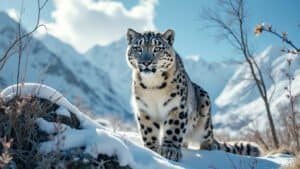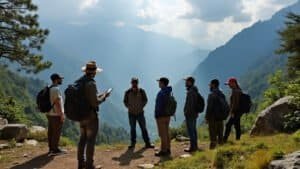Introduction
In snow leopard regions, schools play a crucial role in conservation education, fostering a sense of responsibility among students to protect this endangered species
This article explores how schools incorporate conservation topics into their curricula, the collaborations with conservation organizations, and the teaching methods that are most effective. We’ll also examine the challenges faced by schools in these remote areas and how they measure the success of their conservation education programs
Understanding these efforts is key to ensuring the survival of snow leopards and the preservation of their natural habitats
Overview of Conservation Education in Snow Leopard Regions
Snow leopards, elusive and majestic, inhabit some of the most remote and rugged mountain ranges in the world, primarily across Central and South Asia. These regions, characterized by harsh climates and challenging terrains, also host communities that share their habitat with this endangered species
Schools in these areas have taken on the critical task of incorporating conservation education into their curricula, aiming to raise awareness and foster a culture of environmental stewardship among young people. By educating the next generation, these schools hope to protect snow leopards and their ecosystems from further decline
Importance of Conservation Education for Endangered Species
Conservation education plays a vital role in preserving endangered species like the snow leopard. It serves as a foundation for building awareness about the species’ ecological significance and the threats they face
Educating students about conservation issues fosters a deep understanding of biodiversity and the importance of maintaining healthy ecosystems. In regions where snow leopards are found, conservation education is not just about protecting a single species but about safeguarding entire ecosystems
Snow leopards are apex predators, meaning their survival is crucial for maintaining the balance of the food chain and the overall health of their habitats
Schools in these regions recognize that without early education on the importance of conservation, the local population may not fully understand the impact of their actions on the environment. By integrating conservation topics into everyday learning, students grow up with a strong sense of responsibility toward wildlife and the environment
This education often goes beyond the classroom, influencing family and community attitudes towards conservation. As these students become adults, the hope is that they will continue to advocate for and contribute to conservation efforts, ensuring that snow leopards and other endangered species have a future
Regions Where Snow Leopards Are Found
Snow leopards are native to some of the most inhospitable terrains on Earth, spanning across 12 countries, including China, Mongolia, India, Pakistan, Nepal, Bhutan, and Russia
These regions are characterized by their extreme altitude, steep slopes, and rugged landscapes, often above 3,000 meters (9,800 feet) in elevation. The habitats are not only challenging for the animals but also for the people living in these areas, making the inclusion of conservation education in schools particularly important
In these regions, snow leopards often come into conflict with local communities, primarily due to livestock predation. This conflict is a significant challenge for conservation efforts, as it can lead to retaliatory killings of snow leopards by herders
Schools in these areas play a crucial role in addressing these conflicts through education, teaching students about the importance of protecting snow leopards and providing alternative solutions to mitigate human-wildlife conflict
By focusing on the ecological and cultural significance of snow leopards, schools help foster a sense of pride and responsibility among students, which can lead to more peaceful coexistence between humans and these big cats
Integration of Conservation in School Curricula
The integration of conservation education into school curricula in snow leopard regions is a carefully planned process, often involving collaboration with conservation organizations and local governments
In many cases, conservation topics are woven into subjects like biology, geography, and environmental science, providing students with a multidisciplinary understanding of the issues at hand. For example, a biology lesson might cover the anatomy and behavior of snow leopards, while a geography class might focus on the mountain ecosystems they inhabit
Some schools go beyond the standard curriculum, offering specialized conservation courses or extracurricular activities dedicated to wildlife protection
These programs often include field trips to nearby habitats, where students can observe snow leopards and other wildlife in their natural environments. Such experiences are invaluable, as they provide students with a tangible connection to the subjects they study in class, reinforcing the importance of conservation
Additionally, schools may implement project-based learning, where students undertake research projects or community initiatives focused on snow leopard conservation. These projects not only deepen students’ knowledge but also empower them to take action in their communities
By participating in these activities, students gain practical skills in conservation, from conducting wildlife surveys to developing awareness campaigns. This hands-on approach ensures that conservation education is not just theoretical but also practical and impactful, equipping students with the tools they need to contribute to real-world conservation efforts
Collaboration Between Schools and Conservation Organizations
Effective conservation education in snow leopard regions often relies on the strong partnerships between schools and various conservation organizations
These collaborations bring together the expertise and resources needed to create impactful educational programs that go beyond standard classroom instruction
By working together, schools and conservation groups can provide students with a comprehensive understanding of snow leopard conservation, encouraging them to become active participants in preserving this endangered species
Partnerships with Local and International NGOs
Schools in snow leopard regions frequently partner with both local and international non-governmental organizations (NGOs) dedicated to wildlife conservation
These NGOs provide critical support in the form of educational materials, teacher training, and funding for conservation initiatives. Local NGOs, which often have deep roots in the community, play a crucial role in tailoring conservation messages to be culturally relevant and effective
They understand the specific challenges and opportunities in the region, allowing them to create programs that resonate with students and their families
International NGOs bring global expertise and resources that enhance the effectiveness of these programs. Organizations like the Snow Leopard Trust and the World Wildlife Fund (WWF) have developed specialized curricula and educational resources that are used in schools across snow leopard habitats
These resources include lesson plans, interactive games, and documentaries that make learning about snow leopards engaging and accessible for students of all ages. Furthermore, international NGOs often fund field trips, research projects, and conservation activities that give students hands-on experience in wildlife protection
In many cases, these partnerships extend beyond the classroom. NGOs collaborate with schools to organize community events, such as wildlife festivals or conservation workshops, where students can showcase what they’ve learned and involve their families in conservation efforts
This community-wide engagement is essential for creating a culture of conservation that extends beyond the school environment, ensuring that the lessons learned in the classroom have a lasting impact on the broader community
Role of Wildlife Experts in School Programs
Wildlife experts, including biologists, ecologists, and conservationists, play a significant role in enhancing conservation education in schools located in snow leopard regions
These experts bring a wealth of knowledge and real-world experience that enriches the curriculum and inspires students. By participating in school programs, wildlife experts help bridge the gap between academic learning and practical conservation efforts
Many schools invite wildlife experts to give guest lectures or lead workshops on snow leopard ecology, behavior, and conservation challenges. These sessions provide students with a deeper understanding of the scientific aspects of conservation, such as tracking snow leopards, monitoring their populations, and studying their prey
Experts often share stories from the field, offering students a glimpse into the life of a conservationist and the challenges they face in protecting endangered species
In addition to classroom visits, wildlife experts frequently lead field trips to snow leopard habitats, where students can observe these animals in the wild. These excursions offer invaluable learning opportunities, allowing students to see firsthand the importance of habitat conservation and the impact of human activities on wildlife
By working alongside experts in the field, students gain practical skills in wildlife monitoring and data collection, which can inspire them to pursue careers in conservation science
Moreover, wildlife experts often mentor students who are interested in conducting their own research projects or participating in citizen science initiatives. This mentorship helps students develop critical thinking and research skills, as well as a deeper commitment to conservation
Through these interactions, students not only learn about snow leopards but also gain a broader understanding of global conservation efforts and the role they can play in preserving biodiversity
Case Studies of Successful Collaborations
Several successful collaborations between schools and conservation organizations have had a significant impact on snow leopard conservation education. One notable example is the partnership between the Snow Leopard Trust and schools in the Indian Himalayas
This collaboration has led to the development of a comprehensive conservation curriculum that includes classroom lessons, field trips, and community outreach programs. The Snow Leopard Trust provides schools with educational materials, such as posters, books, and activity guides, that are tailored to the local context. These resources help students learn about snow leopards in a way that is both engaging and relevant to their daily lives
In Mongolia, the Snow Leopard Conservation Foundation has worked closely with local schools to establish “eco-clubs,” where students can participate in conservation activities outside of regular school hours
These clubs provide a platform for students to take an active role in protecting their local environment, from planting trees to reduce soil erosion to organizing anti-poaching campaigns. The success of these eco-clubs has been recognized internationally, and the model is being replicated in other snow leopard regions
Another successful initiative is the “Kids for Cats” program in Kyrgyzstan, developed by Panthera, a global wild cat conservation organization. This program focuses on educating young students about the importance of snow leopard conservation through interactive lessons and hands-on activities
The program has reached thousands of students across the country, fostering a new generation of conservationists who are passionate about protecting their natural heritage
These case studies highlight the importance of collaboration in conservation education. By working together, schools and conservation organizations can create powerful educational experiences that not only inform students but also empower them to make a difference in their communities
These partnerships are essential for ensuring the long-term survival of snow leopards and other endangered species, as they help build a strong foundation of knowledge, skills, and commitment among the next generation
Teaching Methods for Snow Leopard Conservation
Educating students about snow leopard conservation in regions where these elusive cats live requires innovative and diverse teaching methods. Schools employ a variety of approaches to ensure that the message of conservation resonates with students of all ages
These methods are designed to engage students actively, make learning memorable, and inspire them to take part in conservation efforts within their communities
Interactive Learning and Field Trips
Interactive learning is a cornerstone of conservation education in snow leopard regions. Teachers use hands-on activities to make lessons about snow leopards and their ecosystems more engaging and impactful
For example, students might participate in simulations that mimic the challenges snow leopards face, such as finding food in harsh environments or avoiding human conflict. These activities help students empathize with the animals and understand the difficulties they encounter in the wild
Field trips are another critical component of interactive learning. Schools often organize excursions to nearby protected areas or national parks where snow leopards are known to roam
These trips provide students with the unique opportunity to observe wildlife and their habitats directly. Guided by experts, students learn about the importance of preserving these environments and the role that snow leopards play in the ecosystem. Such experiences are particularly powerful because they allow students to connect theoretical knowledge with real-world observations, reinforcing the importance of conservation
In some regions, schools collaborate with local wildlife reserves or conservation centers to offer more immersive experiences. Students might participate in activities like tracking snow leopards using camera traps or monitoring prey populations, which gives them a deeper understanding of the scientific aspects of conservation work
These field experiences are not only educational but also inspire a sense of wonder and responsibility in students, motivating them to protect the natural world
Use of Technology and Digital Resources
Technology plays an increasingly important role in conservation education, especially in remote areas where access to traditional resources may be limited. Schools in snow leopard regions are leveraging digital tools to bring the wonders of wildlife into the classroom and to connect students with global conservation efforts
One common use of technology is through educational videos and documentaries. These visual resources provide students with a close-up view of snow leopards in their natural habitat, showcasing behaviors and environments that are difficult to observe in person
Documentaries produced by organizations like National Geographic or the BBC offer high-quality content that both educates and entertains, making complex ecological concepts more accessible to young learners
Another innovative use of technology is the incorporation of virtual reality (VR) and augmented reality (AR) experiences. These tools allow students to “travel” to the mountainous regions where snow leopards live, experiencing the landscape and wildlife as if they were actually there
VR and AR can be particularly effective in engaging students who may be less interested in traditional forms of learning, offering an immersive and interactive way to explore conservation topics
Digital platforms also enable schools to connect with conservation experts and other students around the world. Through virtual exchanges, students can participate in global conservation projects, share their experiences, and learn from others who are also working to protect endangered species
These connections help students understand the global nature of conservation efforts and how their actions can contribute to a larger cause
Moreover, schools use online resources and apps to track snow leopard populations, analyze environmental data, and participate in citizen science projects. For instance, students might use GPS technology to map snow leopard habitats or contribute to databases that monitor wildlife activity
By engaging with technology in these ways, students not only learn valuable technical skills but also gain a deeper understanding of the challenges and opportunities in wildlife conservation
Student-Led Conservation Projects
Empowering students to take the lead in conservation projects is an effective way to foster a deep, personal commitment to protecting snow leopards
Schools in snow leopard regions often encourage students to design and implement their own conservation initiatives, giving them ownership over the process and outcomes
Student-led projects can take many forms, from organizing awareness campaigns in their communities to conducting scientific research. For example, students might create posters, videos, or social media content that highlights the importance of snow leopard conservation
These campaigns often target both their peers and the broader community, spreading awareness and encouraging others to get involved in conservation efforts
In some schools, students are encouraged to develop and carry out field research projects. These projects might involve monitoring local wildlife populations, studying the effects of climate change on snow leopard habitats, or assessing the impact of human activities on the environment
By engaging in research, students learn valuable skills in data collection, analysis, and reporting, while also contributing to the body of knowledge that supports conservation efforts
Schools may also organize student-led eco-clubs or conservation teams that work on long-term projects. These groups might undertake initiatives such as planting trees to restore degraded habitats, building predator-proof enclosures to protect livestock, or setting up waste management systems to reduce environmental pollution
Through these activities, students learn about the practical challenges of conservation and develop problem-solving skills that are essential for addressing complex environmental issues
One of the key benefits of student-led projects is that they often have a lasting impact. When students take charge of a project, they are more likely to stay engaged and continue their conservation work beyond their school years
These experiences also help students build confidence and leadership skills, empowering them to become advocates for wildlife conservation in their communities and beyond
Challenges in Implementing Conservation Education
Implementing conservation education in snow leopard regions presents several challenges. Schools in these remote and often harsh environments face difficulties ranging from limited resources to cultural and environmental barriers
Despite these obstacles, educators and conservationists work tirelessly to ensure that students receive the knowledge and skills they need to contribute to the protection of snow leopards and their habitats
Resource Constraints and Funding Issues
One of the most significant challenges in implementing conservation education is the lack of resources and funding
Schools in snow leopard regions are often located in remote, economically disadvantaged areas where basic educational needs may not be fully met. This lack of resources can make it difficult to incorporate specialized conservation programs into the curriculum
Funding is a critical issue, as many schools do not have the financial means to provide the necessary materials or to organize field trips and interactive learning experiences
Conservation education often requires specific tools, such as educational kits, wildlife monitoring equipment, or access to digital resources, which may be beyond the budget of these schools. Additionally, teachers may not receive adequate training in conservation topics, further limiting the effectiveness of the education provided
To address these challenges, schools often rely on external support from NGOs, government agencies, and private donors. However, securing consistent funding can be difficult, and many programs operate on a limited budget, which can affect their sustainability and long-term impact
Despite these constraints, educators are resourceful, often finding creative ways to deliver conservation education with the limited resources available, such as by integrating conservation themes into existing subjects or using locally available materials for hands-on activities
Geographic and Environmental Challenges
The geographic and environmental conditions in snow leopard regions pose unique challenges for conservation education. These areas are typically characterized by rugged terrain, high altitudes, and extreme weather conditions, which can make it difficult for students and teachers to access schools regularly
In some regions, schools are located in isolated villages, requiring students to travel long distances on foot or by mule, which can be especially challenging during the harsh winter months
These environmental challenges also affect the ability to conduct field trips and outdoor educational activities, which are essential components of conservation education. Harsh weather conditions, such as heavy snowfall or landslides, can make it unsafe for students to travel to wildlife habitats or conservation sites
This limits the opportunities for students to observe snow leopards and their ecosystems firsthand, which is a critical part of fostering a deep understanding and connection to the species
Moreover, the physical environment itself can be a barrier to learning. High altitudes can affect students’ and teachers’ health, leading to issues such as altitude sickness or fatigue, which can impact the overall effectiveness of the educational process
In some cases, schools may lack proper infrastructure, such as heating or adequate classroom space, making it difficult to maintain a conducive learning environment
To overcome these challenges, schools and conservation organizations often adapt their programs to suit the local conditions. For example, they might schedule outdoor activities during more favorable seasons or use local wildlife that can be observed safely from the village as a proxy for learning about snow leopards
Additionally, some schools are exploring the use of digital learning platforms to deliver conservation education remotely, which can help mitigate the challenges posed by geographic isolation
Cultural and Community Engagement Barriers
Cultural and community engagement barriers are another significant challenge in implementing conservation education. In many snow leopard regions, local communities rely heavily on livestock for their livelihoods, which can lead to conflicts with snow leopards that prey on these animals
This conflict can create negative attitudes toward snow leopards and wildlife conservation in general, making it difficult for schools to promote conservation messages
In some cases, traditional beliefs and practices may also pose challenges. For example, certain cultural practices might include the hunting of wildlife for medicinal purposes or other uses, which can be at odds with conservation efforts
Additionally, there may be a lack of awareness or understanding of the ecological importance of snow leopards and the benefits of conservation, leading to resistance or apathy toward educational programs
To address these barriers, schools and conservation organizations often work closely with local communities to build trust and promote conservation in a culturally sensitive manner
This might involve incorporating local knowledge and traditions into the curriculum, highlighting the cultural significance of snow leopards, or demonstrating how conservation efforts can benefit the community, such as through eco-tourism or improved livestock management practices
Engaging community leaders and involving parents in conservation education is also crucial. When the broader community supports conservation efforts, students are more likely to embrace and apply what they learn in school
Schools may organize community events, workshops, or discussions that include parents and elders, ensuring that conservation education is reinforced at home and within the community. By creating a shared understanding and commitment to conservation, schools can help overcome cultural and engagement barriers, fostering a more supportive environment for snow leopard conservation
Measuring the Impact of Conservation Education
Assessing the effectiveness of conservation education programs in snow leopard regions is crucial to ensure that these initiatives are truly making a difference
Schools and conservation organizations employ various methods to measure the impact of their programs on students, communities, and wildlife conservation efforts. By evaluating these outcomes, educators can refine their approaches, ensuring that conservation education continues to evolve and meet its goals
Evaluating Student Awareness and Attitudes
One of the primary ways to measure the impact of conservation education is by assessing changes in student awareness and attitudes toward snow leopards and conservation
Schools often conduct pre- and post-program surveys to gauge students’ knowledge of snow leopard ecology, the threats these animals face, and the importance of conservation efforts. These surveys can reveal shifts in understanding and highlight areas where further education might be needed
In addition to knowledge, surveys and interviews are used to assess changes in students’ attitudes toward snow leopards
For example, educators might explore whether students have developed a greater appreciation for wildlife or if they are more likely to support conservation initiatives after completing the program. Positive shifts in attitude are often a strong indicator that the education program is effective in fostering a conservation-minded mindset
Another way to evaluate impact is through observing student behavior. Educators may monitor whether students are engaging in conservation activities, such as participating in eco-clubs, leading awareness campaigns, or taking part in community conservation projects
Behavioral changes, such as increased participation in conservation efforts or a willingness to discuss wildlife conservation with family and friends, can provide valuable insights into the program’s success in instilling a commitment to conservation
Long-term Effects on Wildlife Conservation Efforts
Beyond immediate changes in student awareness and attitudes, it’s important to assess the long-term effects of conservation education on wildlife conservation efforts
This can involve tracking students over time to see if they continue to engage in conservation activities or pursue careers in environmental science, ecology, or related fields. Longitudinal studies can help determine whether the conservation values instilled during school have a lasting impact on students’ lives and career choices
Schools and conservation organizations may also evaluate the impact of education programs on local wildlife populations. For example, they might monitor changes in the frequency of human-wildlife conflicts, such as the number of livestock predation incidents or retaliatory killings of snow leopards
A reduction in these conflicts can indicate that conservation education is effectively changing how communities perceive and interact with snow leopards
Additionally, conservation education programs can be linked to broader conservation outcomes, such as the establishment of community-led conservation areas or increased support for protected areas
Schools might work with conservation organizations to track these outcomes, analyzing how education contributes to broader conservation goals, such as population stability or growth in snow leopard numbers. These long-term effects are critical for understanding the true impact of conservation education and for making a case for continued investment in these programs
Examples of Measurable Success in Schools
Several schools in snow leopard regions have demonstrated measurable success in their conservation education programs, providing valuable examples of what works. One such example is the “Eco-Schools” initiative in the Indian Himalayas, where schools have integrated conservation education into their daily routines and have seen significant positive outcomes
Students from these schools have gone on to lead local conservation projects, such as reforestation efforts and wildlife monitoring programs, which have had tangible benefits for both the environment and the community
In Nepal, schools participating in the “Snow Leopard Conservation Education Program” have shown measurable success in reducing human-wildlife conflicts
Through a combination of education, community engagement, and the implementation of predator-proof enclosures for livestock, these schools have helped decrease the number of snow leopards killed in retaliation for livestock predation
The program’s success has been documented through surveys and interviews with local communities, as well as data showing a reduction in livestock losses
Another example is from Mongolia, where schools involved in the “Nomadic Nature Trunks” project have reported significant increases in student knowledge and interest in wildlife conservation. This project provides mobile education units that bring conservation education to remote schools, offering interactive lessons on snow leopards and other local wildlife
Evaluations of the program have shown that students who participate in these lessons are more likely to engage in conservation activities and express a desire to protect their natural environment
These examples highlight the importance of monitoring and evaluation in conservation education. By measuring success and learning from these programs, schools and conservation organizations can refine their approaches, ensuring that education efforts are as effective as possible in fostering a new generation of conservationists who are committed to protecting snow leopards and other endangered species
Conclusion
Conservation education in snow leopard regions is essential for preserving these magnificent creatures and their fragile habitats. Schools play a crucial role in this effort, incorporating conservation topics into their curricula, often in collaboration with NGOs and wildlife experts
By using interactive teaching methods, digital tools, and student-led projects, educators inspire a deep commitment to conservation among students. Despite the challenges posed by limited resources, harsh environments, and cultural barriers, these programs have made significant strides
Measuring the impact of these efforts shows promising results, with positive changes in student awareness, community engagement, and even wildlife conservation outcomes. As these initiatives continue to evolve, they hold the potential to safeguard snow leopards for future generations








